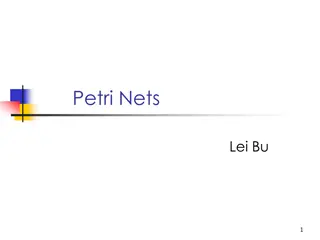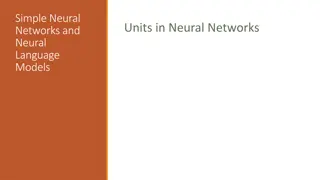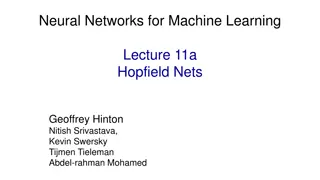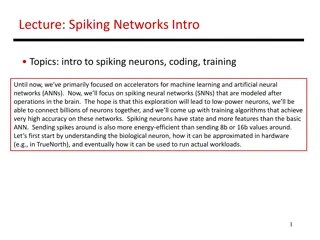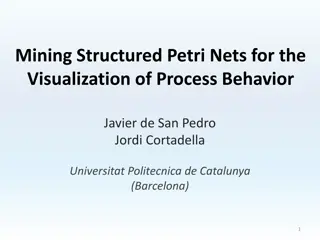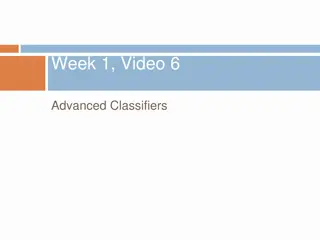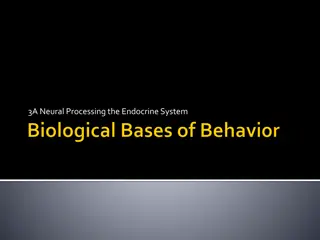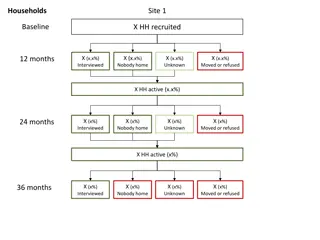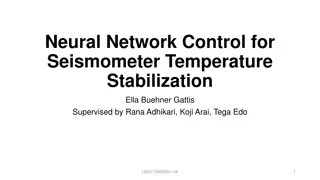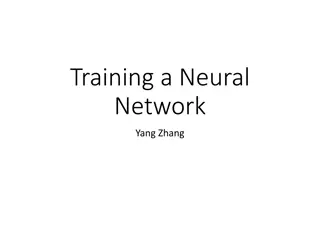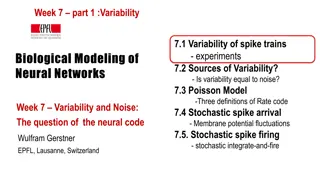
Neural Networks: Mimicking the Human Nervous System
Explore how neural networks attempt to replicate the structure and function of the human nervous system, focusing on neurons and synapses. Learn about the connections between nodes, weights, and thresholds in artificial neural networks. Discover various activation functions used in neural networks, such as hard threshold, sigmoid, and softmax, to process and transmit signals effectively.
Download Presentation

Please find below an Image/Link to download the presentation.
The content on the website is provided AS IS for your information and personal use only. It may not be sold, licensed, or shared on other websites without obtaining consent from the author. If you encounter any issues during the download, it is possible that the publisher has removed the file from their server.
You are allowed to download the files provided on this website for personal or commercial use, subject to the condition that they are used lawfully. All files are the property of their respective owners.
The content on the website is provided AS IS for your information and personal use only. It may not be sold, licensed, or shared on other websites without obtaining consent from the author.
E N D
Presentation Transcript
NEURAL NETWORKS David Kauchak CS159 Spring 2024
Admin Assignment 5
Neural Networks Neural Networks try to mimic the structure and function of our nervous system People like biologically motivated approaches
Our Nervous System Neuron What do you know?
Our nervous system: the computer science view the human brain is a large collection of interconnected neurons a NEURON is a brain cell they collect, process, and disseminate electrical signals they are connected via synapses they FIRE depending on the conditions of the neighboring neurons
Artificial Neural Networks Node (Neuron) Edge (synapses) our approximation
Node A Node B Weight w (neuron) (neuron) W is the strength of signal sent between A and B. If A fires and w is positive, then A stimulatesB. If A fires and w is negative, then A inhibitsB.
Neurons often have many, many connected input neurons If a neuron is stimulated enough, then it also fires How much stimulation is required is determined by its threshold
A Single Neuron/Perceptron Input x1 Each input contributes: xi * wi Weight w1 Weight w2 Input x2 g(in) Output y threshold function Input x3 Weight w3 i in = wi xi Weight w4 Input x4
Activation functions hard threshold: ? ?? = 1 ?? ?? ? ?? ?????? 0 sigmoid 1 g(x) = 1+e-ax tanh x why other threshold functions?
Many other activation functions Rectified Linear Unit Softmax (for probabilities)
A Single Neuron/Perceptron 1 ? ?? = 1 ?? ?? ? ?? ?????? 1 0 -1 ? 1 0 1 Threshold of 1 0.5 1
A Single Neuron/Perceptron 1 ? ?? = 1 ?? ?? ? ?? ?????? 0 1 -1 ? 1 0 1 Threshold of 1 0.5 1 1*1 + 1*-1 + 0*1 + 1*0.5 = 0.5
A Single Neuron/Perceptron 1 ? ?? = 1 ?? ?? ? ?? ?????? 1 0 -1 0 1 Weighted sum is 0.5, which is not larger than the threshold 0 1 Threshold of 1 0.5 1
A Single Neuron/Perceptron 1 ? ?? = 1 ?? ?? ? ?? ?????? 1 0 -1 ? 0 0 1 Threshold of 1 0.5 1 1*1 + 0*-1 + 0*1 + 1*0.5 = 1.5
A Single Neuron/Perceptron 1 ? ?? = 1 ?? ?? ? ?? ?????? 1 0 -1 1 0 Weighted sum is 1.5, which is larger than the threshold 0 1 Threshold of 1 0.5 1
Neural network inputs Individual perceptrons/neurons
Neural network some inputs are provided/entered inputs
Neural network inputs each perceptron computes and calculates an answer
Neural network inputs those answers become inputs for the next level
Neural network inputs finally get the answer after all levels compute
Computation (assume threshold 0) 0.5 0 0 1 0.5 -1 -0.5 1 0.5 1 1 ? ?? = 1 ?? ?? ? ?? ?????? 0
Computation -0.05-0.02= -0.07 0.483 0.05 0.483*0.5+0.495=0.7365 -1 0.5 0.03 -0.02 0.676 1 0.01 1 0.495 -0.03+0.01=-0.02
Neural networks Different kinds/characteristics of networks inputs inputs inputs inputs How are these different?
Hidden units/layers inputs inputs hidden units/layer Feed forward networks
Hidden units/layers inputs Can have many layers of hidden units of differing sizes To count the number of layers, you count all but the inputs
Hidden units/layers inputs inputs 2-layer network 3-layer network
Alternate ways of visualizing Sometimes the input layer will be drawn with nodes as well inputs inputs 2-layer network 2-layer network
Multiple outputs inputs 0 1 Can be used to model multiclass datasets or more interesting predictors, e.g. images
Multiple outputs input output (edge detection)
Neural networks inputs Recurrent network Output is fed back to input Can support memory! Good for temporal data
History of Neural Networks McCulloch and Pitts (1943) introduced model of artificial neurons and suggested they could learn Hebb (1949) Simple updating rule for learning Rosenblatt (1962) - the perceptron model Minsky and Papert (1969) wrote Perceptrons Bryson and Ho (1969, but largely ignored until 1980s-- Rosenblatt) invented back-propagation learning for multilayer networks
Training the perceptron First wave in neural networks in the 1960 s Single neuron Trainable: its threshold and input weights can be modified If the neuron doesn t give the desired output, then it has made a mistake Input weights and threshold can be changed according to a learning algorithm
Examples - Logical operators AND if all inputs are 1, return 1, otherwise return 0 OR if at least one input is 1, return 1, otherwise return 0 NOT return the opposite of the input XOR if exactly one input is 1, then return 1, otherwise return 0
AND x1 x2 x1 and x2 0 0 0 0 1 0 1 0 0 1 1 1
x1 0 0 1 1 x2 0 1 0 1 x1 and x2 0 0 0 1 AND Input x1 W1 = ? Output y T = ? Input x2 W2 = ?
x1 0 0 1 1 x2 0 1 0 1 x1 and x2 0 0 0 1 AND Input x1 W1 = 1 Output y T = 2 Output is 1 only if all inputs are 1 Input x2 W2 = 1 Inputs are either 0 or 1
AND Input x1 W1 = ? W2 = ? Input x2 Output y T = ? Input x3 W3 = ? W4 = ? Input x4
AND Input x1 W1 = 1 W2 = 1 Input x2 Output y T = 4 Output is 1 only if all inputs are 1 Input x3 W3 = 1 W4 = 1 Input x4 Inputs are either 0 or 1
OR x1 x2 x1 or x2 0 0 0 0 1 1 1 0 1 1 1 1
x1 x2 x1 or x2 OR 0 0 0 0 1 1 Input x1 1 0 1 W1 = ? 1 1 1 Output y T = ? Input x2 W2 = ?
x1 x2 x1 or x2 OR 0 0 0 0 1 1 Input x1 1 0 1 W1 = 1 1 1 1 Output y T = 1 Output is 1 if at least 1 input is 1 Input x2 W2 = 1 Inputs are either 0 or 1
OR Input x1 W1 = ? W2 = ? Input x2 Output y T = ? Input x3 W3 = ? W4 = ? Input x4
NOT x1 not x1 0 1 1 0
OR Input x1 W1 = 1 W2 = 1 Input x2 Output y T = 1 Output is 1 if at least 1 input is 1 Input x3 W3 = 1 W4 = 1 Input x4 Inputs are either 0 or 1
x1 0 1 not x1 1 0 NOT W1 = ? Input x1 T = ? Output y
NOT W1 = -1 Input x1 T = 0 Output y If input is 1, output is 0. If input is 0, output is 1. Input is either 0 or 1
How about x1 x2 x3 x1 and x2 1 0 0 0 Input x1 w1 = ? 0 1 0 0 w2 = ? 1 0 0 1 Input x2 Output y T = ? 1 1 0 0 Input x3 w3 = ? 0 0 1 1 0 1 1 1 1 0 1 1 1 1 1 0
Training neural networks Learn individual node parameters (e.g. threshold) Learn the individual weights between nodes
Positive or negative? NEGATIVE

